I haven't provided detailed commentary on the US labour market for a while now. To…
Australian labour market – continues to deteriorate – fiscal stimulus needed
The last few months Australian Bureau of Statistics data has shown that Austrlia is becoming a nation of part-time employment. The latest labour force data released today by the Australian Bureau of Statistics – Labour Force data – for September 2016 shows that trend to be intensifying with negative employment growth being recorded for the second consecutive month and a 0.4 decline in the participation rate over the same period. Over the last 12 months, Australia has produced a total (net) of 163.1 thousand jobs overall with 196.1 thousand part-time jobs being offset by the higher quality loss of 86.5 thousand jobs. Australia maintains its status as the nation of part-time employment growth with all the attendant negative consequences. Further, the only reason that the unemployment level and rate fell is because the labour force shrank faster than total employment. This was due to the 0.2 percentage point decline in participation. The teenage labour market remains in a poor state and requires urgent policy intervention. Overall, with weak private investment now on-going, the Australian labour market is looking in pretty dismal shape and the Federal government should immediately renounce its ill-informed austerity narrative and announce a rather sizeable fiscal stimulus to provide some fiscal leadership to the nation. This should include a large-scale public sector job creation program which would ensure teenagers regained the jobs that have been lost due to the fiscal drag over the last several years. The deteriorating data is staring us all in the face now! There is no room for nuance.
The summary ABS Labour Force (seasonally adjusted) estimates for September 2016 are:
- Employment decreased 9,800 (-0.1 per cent) with full-time employment decreasing by 53,000 and part-time employment increasing by 43,200.
- Unemployment fell by 12,500 to 705,100 but only because the participation rate fell sharply.
- The official unemployment rate fell to 5.6 per cent (0.1 points).
- The participation rate declined by 0.2 points to 64.5 per cent. It has fallen by 0.4 pts in the last two months and is well below its November 2010 peak (recent) of 65.8 per cent.
- Aggregate monthly hours worked increased 4 million hours (0.24 per cent).
- In the August quarter, underemployment rose by 38.1 thousand at 8.7 per cent of the labour force. The total labour underutilisation rate (unemployment plus underemployment) rose by 0.1 per cent to 14.3 per cent. There were 1,0110.1 thousand persons underemployed and a total of 1,8815.2 thousand workers either unemployed or underemployed.
Employment growth – second negative month in a row
In seasonally-adjusted terms, total (net) employment in September 2016 is estimated to have decreased 9,800 jobs with full-time employment decreasing by 53,000 and part-time employment increasing by 43,200.
I indicated several months ago that Australia was becoming a part-time employment nation. That trend is now consolidating.
The ABS said that in terms of its trend data:
The latest Labour Force release shows further increases in part-time employment. There are now 130,000 more persons working part-time than in December 2015, while the number working full-time has decreased by 54,100 persons
The Australian economy is becoming dominated by part-time work – with the attendent ramifications of low-pay, precarious attachments and other negative characteristics.
In seasonally-adjusted terms, 82.3 per cent of the net jobs created in Australia in the last 12 months have been part-time.
Over the last 6 months this trend intensified, with full-time employment going backwards and part-time employment accounting for 282 per cent of the net job creation (see below).
The zig-zag pattern that we have observed over the last 36 months or so – where the employment estimates have been switching back and forth regularly between negative employment growth and positive growth with the occasional spikes – continues.
The following graph shows the month by month growth in full-time (blue columns), part-time (grey columns) and total employment (green line) for the 24 months to September 2016 using seasonally adjusted data.
It gives you a good impression of just how flat employment growth has been over the last 2 years. You can also see the dominance of part-time employment growth over the same period, especially in the last year or so.
The following table provides an accounting summary of the labour market performance over the last six months. The monthly data is highly variable so this Table provides a longer view which allows for a better assessment of the trends. WAP is working age population (above 15 year olds).
Full-time employment has fallen by a massive 66.5 thousand jobs (net) while part-time work has risen by 102.9 thousand jobs.
The conclusion – overall there have only been 36.4 thousand jobs (net) added in Australia over the last six months while the labour force has barely increased by 19.7 thousand. Employment growth has thus outstripped the sluggish labour supply growth with the result that unemployment has fallen by 16.7 thousand.
Employment growth (particularly the quality of the jobs) has been weak by historical standards given that the labour force growth has been very subdued, and labour force participation has declined markedly (-0.4 percentage points). The participation rate remains at depressed levels.
Overall – a fairly subdued labour market.
The following graph shows employment indexes for the last 3 recessions and allows us to see how the trajectory of total employment after each peak prior to the three major recessions in recent history: 1982, 1991 and 2009 (the latter to capture the current episode).
The peak is defined as the month of the low-point unemployment rate in the relevant cycle and total employment was indexed at 100 in each case and then indexed to that base for each of the months as the recession unfolded.
I have plotted the 3 episodes for 102 months after the low-point unemployment rate was reached in each cycle – the length of the current cycle.
The initial employment decline was similar for the 1982 and 1991 recessions but the 1991 recovery was delayed by many months and the return to growth much slower than the 1982 recession.
The current episode is distinguished by the lack of a major slump in total employment, which reflects the success of the large fiscal stimulus in 2008 and 2009.
However, the recovery spawned by the stimulus clearly dissipated once the fiscal position was reversed and the economy fell back into producing very subdued employment outcomes.
Since February 2008, employment has grown by a miserly 12.2 per cent, which is a very slow pace in historical terms for such a long period.
Given the variation in the labour force estimates, it is sometimes useful to examine the Employment-to-Population ratio (%) because the underlying population estimates (denominator) are less cyclical and subject to variation than the labour force estimates. This is an alternative measure of the robustness of activity to the unemployment rate, which is sensitive to those labour force swings.
The following graph shows the Employment-to-Population ratio, since February 2008 (the low-point unemployment rate of the last cycle).
It dived with the onset of the GFC, recovered under the boost provided by the fiscal stimulus packages but then went backwards again as the last Federal government imposed fiscal austerity in a hare-brained attempt at achieving a fiscal surplus.
The ratio began rising in October 2014 which suggested to some that the labour market had bottomed out and would improve slowly as long as there are no major policy contractions or cuts in private capital formation.
However, the peak in November is now gone and the ratio is once again in retreat or barely rising.
The on-going fiscal deficit is still supporting some growth in the economy as the spending associated with the mining boom disappears. But the deficit is clearly too small given the behaviour of the real aggregates.
The series declined by 0.1 points in September 2016 but remains 1.9 points below the April 2008 peak of 62.9 per cent.
So for those commentators who were praising the rise in the EPOP ratio over 2015, they will have to reappraise their assessments. The labour market is deteriorating.
Teenage labour market – weakness continues
The teenage labour market saw full-time employment ise by 3.7 thousand and part-time employment rising by 0.1 thousand (net) jobs in September 2016.
Total employment thus rose by 3.8 thousand (net), which defied the national overall trend.
The following graph shows the distribution of net employment creation in the last month by full-time/part-time status and age/gender category (15-19 year olds and the rest)
Over the last 12 months, teenagers have gained only 22.6 thousand (net) jobs overall while the rest of the labour force have gained 140.5 thousand net jobs. Remember that the overall result represents a fairly poor annual growth in employment.
However, full-time employment growth for teenagers over the last 12 months has been negative – down by 13.3 thousand.
The teenage segment of the labour market is being particularly dragged down by the sluggish employment growth, which is hardly surprising given that the least experienced and/or most disadvantaged (those with disabilities etc) are rationed to the back of the queue by the employers.
The following graph shows the change in aggregates over the last 12 months. It is as if the teenagers have not had a stake in the labour market either way (blue bars barely visible).
To further emphasise the plight of our teenagers, the following graph extends the time period from February 2008, which was the month when the unemployment rate was at its low point in the last cycle, to the present month (September 2016). So it includes the period of downturn and then the so-called ‘recovery’ period. Note the change in vertical scale compared to the previous two graphs.
Since February 2008, there have been only 1,299.6 thousand (net) jobs added to the Australian economy but teenagers have lost a staggering 85.2 thousand over the same period. It is even more stark when you consider that 121.7 thousand full-time teenager jobs have been lost in net terms.
Even in the traditionally, concentrated teenage segment – part-time employment, teenagers have gained only 36.5 thousand jobs (net) even though 835.4 thousand part-time jobs have been added overall.
Overall, the total employment increase is modest. Further, around 65 per cent of the total (net) jobs added since February 2008 have been part-time, which raises questions about the quality of work that is being generated overall.
To put the teenage employment situation in a scale context the following graph shows the Employment-Population ratios for males, females and total 15-19 year olds since February 2008 (the month which coincided with the low-point unemployment rate of the last cycle).
You can interpret this graph as depicting the loss of employment relative to the underlying population of each cohort. We would expect (at least) that this ratio should be constant if not rising somewhat (depending on school participation rates).
The facts are that the absolute loss of jobs reported above is depicting a disastrous situation for our teenagers. Males, in particular, have lost out severely as a result of the economy being deliberately stifled by austerity policy positions.
In the latter months of 2015, with the part-time employment situation improving, there was some reversal in the downward trends in these ratios.
However, it appears that the ratios are now flattening out along.
The male ratio has fallen by 10.3 percentage points since February 2008, the female ratio has fallen by 4.4 percentage points and the overall teenage employment-population ratio has fallen by 7.4 percentage points. That is a substantial decline in the employment market for Australian teenagers.
The other staggering statistic relating to the teenage labour market is the decline in the participation rate since the beginning of 2008 when it peaked in January at 61.4 per cent. In September 2016, the participation rate was just 53.8 per cent (a decline of 0.8 points since August).
That is an additional 112.1 thousand teenagers who have dropped out of the labour force as a result of the weak conditions since the crisis.
If we added them back into the labour force the teenage unemployment rate would be 26.9 per cent rather than the official estimate for September 2016 of 16.6 per cent. Some may have decided to return to full-time education and abandoned their plans to work. But the data suggests the official unemployment rate is significantly understating the actual situation that teenagers face in the Australian labour market.
Overall, the performance of the teenage labour market remains poor. It doesn’t rate much priority in the policy debate, which is surprising given that this is our future workforce in an ageing population. Future productivity growth will determine whether the ageing population enjoys a higher standard of living than now or goes backwards.
I continue to recommend that the Australian government immediately announce a major public sector job creation program aimed at employing all the unemployed 15-19 year olds, who are not in full-time education or a credible apprenticeship program.
Unemployment fell by 12,500 to 705,100 but only because the participation rate fell sharply
The official unemployment rate fell to 5.6 per cent (0.1 points) in September 2016 but only because the labour force participation rate fell by 0.2 points as employment growth turned negative and workers clearly dropped out of the labour force.
In other words, the falling unemployment just resulted in a rise in hidden unemployment – a case where a declining unemployment rate is not a beneficial outcome.
Overall, the labour market still has significant excess capacity available in most areas and what growth there is is not making any major inroads into the idle pools of labour.
The following graph shows the national unemployment rate from February 1978 to September 2016. The longer time-series helps frame some perspective to what is happening at present.
After falling steadily as the fiscal stimulus pushed growth along, the unemployment rate slowly trended up for some months.
It is now above the peak that was reached just before the introduction of the fiscal stimulus. In other words, the gains that emerged in the recovery as a result of the fiscal stimulus in 2009-10 have now been lost.
Given the weak (negative) employment growth, the unemployment rate would be much higher if the labour force was growing as previous trend rates (see analysis below).
Broad labour underutilisation – 14.3 per cent
The ABS published its quarterly broad labour underutilisation measures for the August-quarter in this month’s data release.
In the August-quarter, total underemployment was 8.7 per cent (1,110.1 persons – up by 38.1 thousand or 3.6 per cent since May) and the ABS broad labour underutilisation rate (the sum of unemployment and underemployment) was 14.3 per cent (up by 0.1 percentage points).
There were 1,110.1 thousand persons underemployed and a total of 1,815.2 thousand workers either unemployed or underemployed.
The rising underemployment is consistent with the trend where Australia is becoming a part-time employment nation.
The following graph plots the history of underemployment in Australia since February 1978 to the February-quarter 2015.
The next graph shows the evolution of the broad underutilisation rate over the same period. You can see the three cyclical peaks corresponding to the 1982, 1991 recessions and the more recent downturn.
Unemployment was a higher proportion of the two earlier peaks but underemployment now dominates the current cycle (just).
The other difference between now and the two earlier cycles is that the recovery triggered by the fiscal stimulus in 2008-09 did not persist and as soon as the ‘fiscal surplus’ fetish kicked in in 2012, things went backwards very quickly.
The two earlier peaks were sharp but steadily declined. The last peak fell away on the back of the stimulus but turned again when the stimulus was withdrawn.
If hidden unemployment (given the depressed participation rate) is added to the broad ABS figure the best-case (conservative) scenario would see a underutilisation rate well above 16 per cent at present. Please read my blog – Australian labour underutilisation rate is at least 13.4 per cent – for more discussion on this point.
The next update will be for the November-quarter 2016 and will be published published in the December 2016 Labour Force release. In between those releases, monthly estimates are available.
Aggregate participation rate – declines by 0.2 points to 64.5 per cent and remains at depressed levels
The September 2016 participation rate decreased by 0.2 pts to 64.5 per cent. It has declined by 0.4 points over the last two months indicating a major slowdown in employment growth.
The participation rate remains substantially down on the most recent peak in November 2010 of 65.8 per cent when the labour market was still recovering courtesy of the fiscal stimulus.
Unemployment fell by 12.5 thousand this month but if the participation rate had not fallen in September 2016, total unemployment and the unemployment rate would have risen.
By how much?
The labour force is a subset of the working-age population (those above 15 years old). The proportion of the working-age population that constitutes the labour force is called the labour force participation rate. Thus changes in the labour force can impact on the official unemployment rate, and, as a result, movements in the latter need to be interpreted carefully. A rising unemployment rate may not indicate a recessing economy.
The labour force can expand as a result of general population growth and/or increases in the labour force participation rates.
What would have the unemployment rate been had the participation rate not fallen by 0.2 points in September 2016?
The following Table shows the breakdown in the changes to the main aggregates (Labour Force, Employment and Unemployment) and the impact of the rise in the participation rate.
In September 2016, employment fell by 9.8 thousand (net) jobs was accompanied by a labour force decrease of 22.3 thousand. As a result, unemployment fell by 12.5 thousand.
In other words, unemployment because the labour force shrank faster than the fall in employment.
The falling labour force in September 2016 was the outcome of two separate factors:
- The underlying population growth added 16.1 thousand persons to the labour force. The population growth impact on the labour force aggregate is relatively steady from month to month but has slowed in recent months; and
- The fall in the participation rate meant that there were 38.4 thousand workers dropping out of the labour force (relative to what would have occurred had the participation rate remained unchanged).
- The net result was the fall in the labour force of 22.3 thousand (rounded).
If the participation rate had not have fallen, total unemployment, at the current employment level, would have been 743.4 thousand rather than the official count of 705.1 thousand as recorded by the ABS – a difference of 38.4 thousand workers (the ‘participation effect’).
Thus, without the fall in the participation rate in September 2016, the unemployment rate would have been 5.9 per cent (rounded) rather than its current value of 5.6 per cent.
The conclusion is that hidden unemployment rose slightly in April 2016 while official unemployment rate remained unchanged.
There is considerable monthly fluctuation in the participation rate but the current rate of 64.5 per cent is a long way below its most recent peak in November 2010 of 65.8 per cent.
What would the unemployment rate be if the participation rate was at the last November 2010 peak level value?
The following graph tells us what would have happened if the participation rate had been constant over the period November 2010 to September 2016. The blue line is the official unemployment rate since its most recent low-point of 4 per cent in February 2008.
The red line starts at November 2010 (the peak participation month). It is computed by adding the workers that left the labour force as employment growth faltered (and the participation rate fell) back into the labour force and assuming they would have been unemployed. At present, this cohort is likely to comprise a component of the hidden unemployed (or discouraged workers).
In recent months the gap between the lines has diverged which signals a deteriorating situation.
Total official unemployment in September 2016 was estimated to be 705.1 thousand. However, if participation had not have fallen relative to November 2010, there would be 956.5 thousand workers unemployed given growth in population and employment since November 2010.
The unemployment rate would now be 7.4 per cent if the participation had not fallen below its November 2010 peak of 65.8 per cent. The official unemployment in September 2016 was 5.6 per cent.
The difference between the two numbers mostly reflects, the change in hidden unemployment (discouraged workers) since November 2010. These workers would take a job immediately if offered one but have given up looking because there are not enough jobs and as a consequence the ABS classifies them as being Not in the Labour Force.
There has been some change in the age composition of the labour force (older workers with low participation rates becoming a higher proportion) but this only accounts for less than 1/3 of the shift. The rest is undoubtedly accounted for by the rise in hidden unemployment.
Note, the gap between the blue and red lines doesn’t sum to total hidden unemployment unless November 2010 was a full employment peak, which it clearly was not. The interpretation of the gap is that it shows the extra hidden unemployed since that time.
This gap shrinks as participation rises relative to the November 2010 peak.
Hours worked – rose by 0.2 per cent in September 2016
Aggregate monthly hours rose by 4 million hours (0.24 per cent) in September 2016 in seasonally adjusted terms.
The following graph shows the monthly growth (in per cent) over the last 24 months. The dark linear line is a simple regression trend of the monthly change – which depicts a negative trend
You can see the pattern of the change in working hours is also portrayed in the employment graph – zig-zagging across the zero growth line.
Conclusion
I repeat my standard monthly warning – we always have to be careful interpreting month to month movements given the way the Labour Force Survey is constructed and implemented.
Today’s figures show that employment growth has once again contracting confirming the pattern for some years now where the growth rate fluctuates between barely positive and negative.
The trend to increased part-time work strengthened in September 2016. The quality of work (wages, job security, superannuation etc) in a deteriorating overall environment is declining.
Over the last 12 months, Australia has produced a total (net) of 163.1 thousand jobs overall with 196.1 thousand part-time jobs being offset by the higher quality loss of 86.5 thousand jobs.
It is clear that Australia maintains its status as the nation of part-time employment growth with all the attendant negative consequences.
The only reason that the unemployment level and rate fell is because the labour force shrank faster than total employment. This was due to the 0.2 percentage point decline in participation.
That is a sure sigh of a weak labour market – when employment growth is negative but unemployment falls!
The conclusion remains that the overall demand side of the labour market is very weak.
The teenage labour market remains in a poor state even though the 15-19 year olds enjoyed some part-time employment growth.
I consider this situation to warrant immediate attention by the Federal Government. The neglect of our teenagers will have a very long memory indeed and the negative consequences will be stronger given the ageing population.
The Federal government appears unwilling to address this dire issue.
That is enough for today!
(c) Copyright 2016 William Mitchell. All Rights Reserved
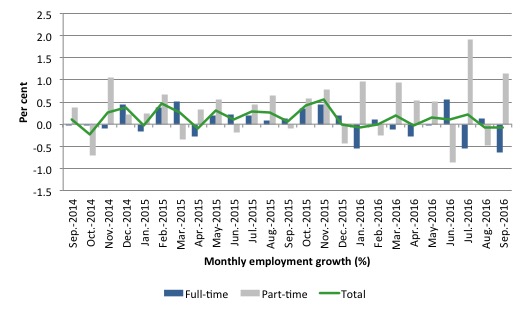
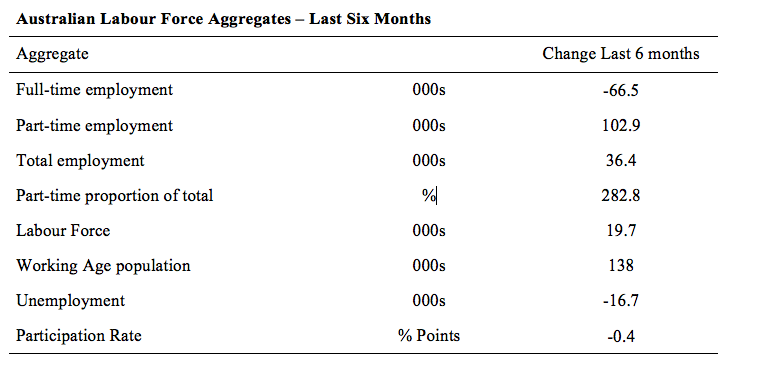
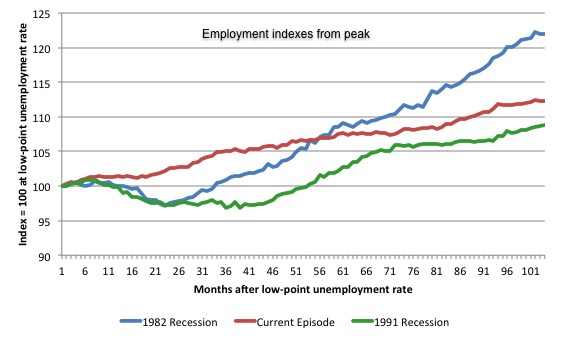
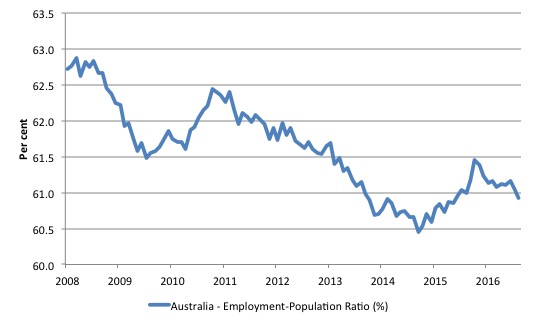
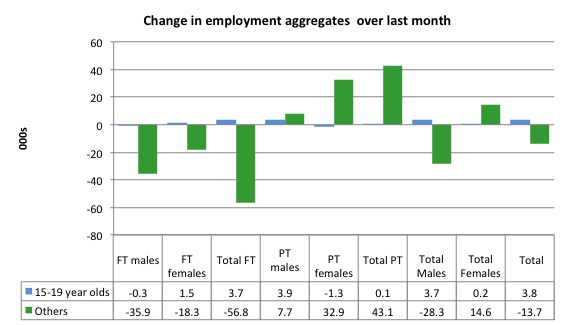
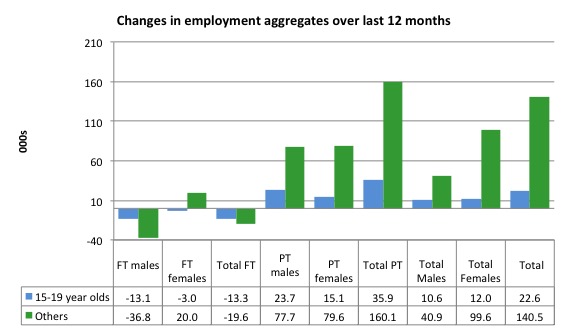
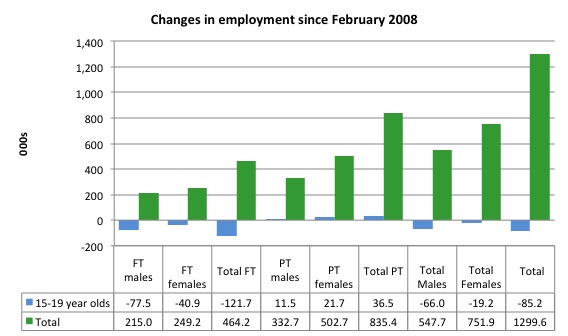
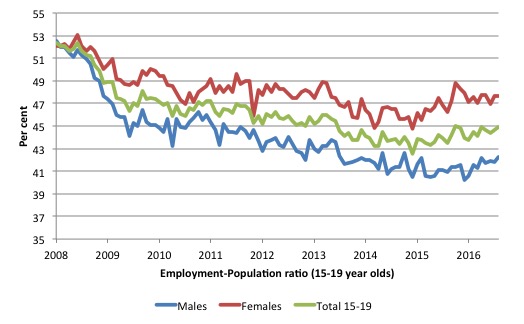
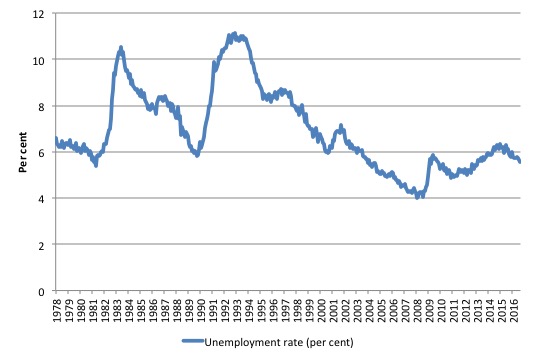
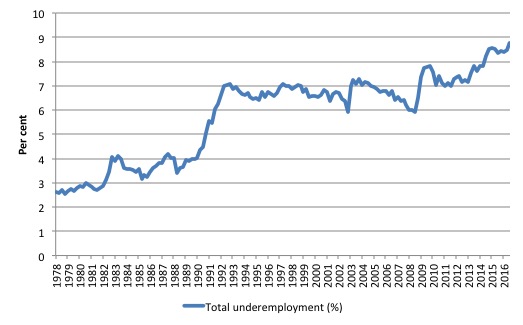
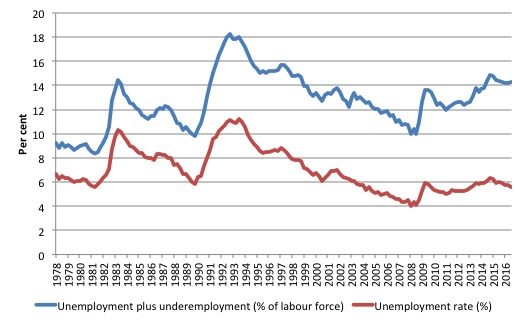
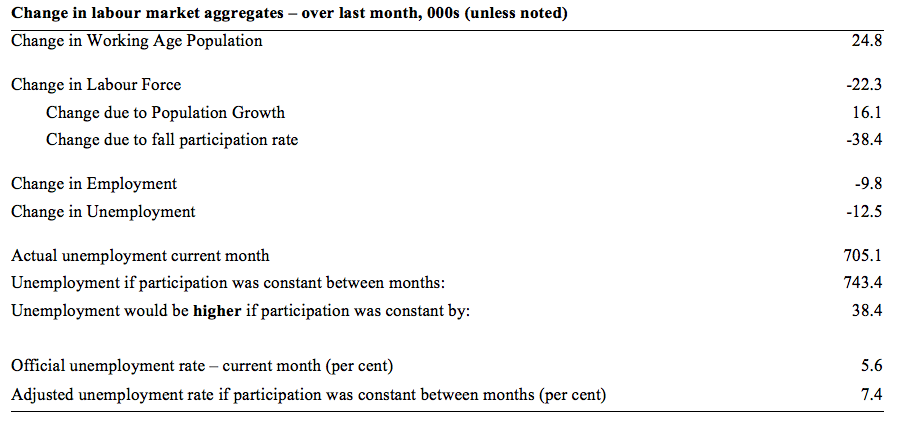
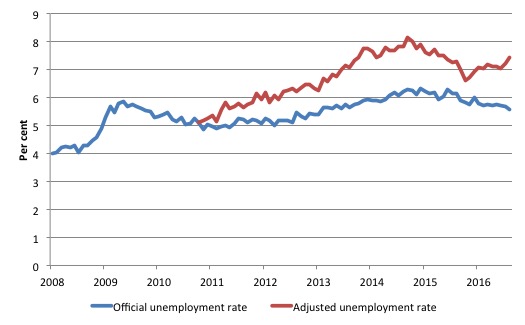

Hi Bill, you wrote an article a ways back on why the unemployment rate is not the best indicator, but rather, is the output of other things like the LFPR and employment flows. I’m finding it difficult to locate given you’ve written a lot on the subject of Aussie employment.
If you get a moment, do you mind linking to it?
Many thanks
Do you mean Gross Flows and Transition Probabilities? If so, US labour market – some improvement but still soft has information on that.
Hi Bill….two cents from this side of the pond…problem not limited to Australia-with a dash of politics….
President Obama/Council of Economic Advisers/Presidential Innovation Fellows:
WE NEED TO CHANGE THE DIALOGUE….
There is universal agreement by every politician in the 2016 election on our need for “Jobs, Jobs, Jobs”–but we cannot create jobs in the absence of a viable Job Creation methodology-and to change our current antiquated/unworkable method of Job Creation [that the market can provide everybody with work—which has not created an unemployment rate below 3% since 1953, with a resulting epidemic of gun violence in our inner-cities]-
AND, to make this urgently needed change–WE need to change the dialogue-Since WW II our focus on the need for Job Creation has been based on the adverse impact on the individual-and not to diminish this in the slightest, but the other side of this coin is the devastation caused to the MARKET, as a result of unemployment-people do not buy what we manufacture when they are jobless-Unemployment is a NO ONE WINS: The jobless lose, civility loses [Ferguson, etc.], and the MARKET loses, to wit:
OUR SLUGGISH ECONOMY RESULTING FROM THE LAW OF DIMINISHED INCOME TO THE MARKET FROM UNEMPLOYMENT [hereafter D/UE LAW]
3% is the zero-sum threshold above which unemployment triggers inflation by diminishing labor training and skills, under-utilizing capital resources, reducing the rate of productivity advance, increasing unit labor costs, reducing the general supply of goods and services–and the loss in income to the Market is compounded exponentially with each percentage point of increase in unemployment, above 3%.
The bottom line is, to get the change EVERYONE agrees we urgently need-we need to change the dialogue-we need to change the emphasis-and get the Koch bros [a metaphor for the 1%]-to look at the income the market is losing because of their “one foot on the plantation” mind-set—-not saying this will be easy—i.e, to engage the 1% in a solution that will benefit EVERYONE-to point out how UE adversely impacts the bottom line….but it is unlikely this change will ever come about until we change the dialogue, and the Koch bros see Humphrey-Hawkins for what it actually is: A Pro-Market solution in our 21st Century market economy.
Ref: HR 1000 [in Committee], THE NEIGHBOR-TO-NEIGHBOR JOB CREATION ACT [NTN], IT IS IMPOSSIBLE TO BE A CHRISTIAN, AND VOTE REPUBLICAN, Amazon/Kindle
Jim Green, Democrat opponent to Lamar Smith, Congress, 2000
Thank you for contacting the White House!
Tks Allan, no I think it was Aussie-centric … but I do need to read your link again though! It’s a good one.
William Mitchell in Winnipeg Free Press
Letter to Editor (with footnotes)
http://www.winnipegfreepress.com/opinion/letters_to_the_editor/letters-and-comments-oct-15-397174421.html
Focus on jobs, not fiscal balance
Re: Morneau, private-sector economists set to examine fate of federal finances, Andy Blatchford, 10/12/2016
http://www.winnipegfreepress.com/canada/morneau-private-sector-economists-set-to-examine-fate-of-federal-finances-396861111.html
Fiscal benchmarks have no true economic justification in today’s fiat money system, but they serve as a useful tool for anti-government ideologues hoping to restrict federal activity. What can explain the shifting definition of a fiscal anchor that ranges from “balancing the budget”, to “keeping deficits modest”, to “ensuring stable debt-to-GDP ratios”, differences that encompass tens of billions of dollars?
The determinant restraint on spending should be the resource capacity of the economy. Finance Minister Bill Morneau is quite right to focus on real-world effects, particularly the unemployment rate. Through targeted spending, 1.3 million Canadians can be given the opportunity to contribute to society. Then fiscal prudence is warranted to forestall inflation.
As Australian economist William Mitchell states,”Forget the deficit. Forget the fiscal balance. Focus on what matters – employment, equity, environmental sustainability. And as we would soon see – the fiscal balance will just be whatever it is – a relatively uninteresting and irrelevant statistical artifact.”
Footnotes:
1. William Mitchell is Professor in Economics and Director of the Centre of Full Employment and Equity (CofFEE), University of Newcastle, NSW, Australia https://billmitchell.org/blog/?p=31487
“There is no rational economic reason, for a currency-issuing government, to think that a balanced fiscal position is responsible, desirable or even possible.
The fiscal balance should never be a policy target – whether it be an immediate aim or some stretched goal into the future.
The relevant goals should be about the outcomes that make societies prosperous and inclusive – goods schools and hospitals, good public transport, full employment, strong income support safety nets for those who cannot work, socially responsible minimum wages etc.
***
Forget the deficit. Forget the fiscal balance. Focus on what matters – employment, equity, environmental sustainability. And as we would soon see – the fiscal balance will just be whatever it is – a relatively uninteresting and irrelevant statistical artifact.”
2. L. Randall Wray is a Professor of Economics at the University of Missouri-Kansas City and Senior Scholar at the Levy Economics Institute of Bard College, NYL. http://neweconomicperspectives.org/2015/11/mmt-and-bernie-sanders.html#comment-1232342
How can a country’s financial condition remain sound and stable when the state can issue money whenever needed?
The danger of spending too much money is inflation; there might also be an impact on exchange rates. The solution to the first problem is to avoid spending more once full employment is reached; and to carefully target spending even before full employment to avoid bottlenecks. The solution to the second is to float the currency.
__________________________________________
Modern Monetary Theory in Canada
http://mmtincanada.jimdo.com/